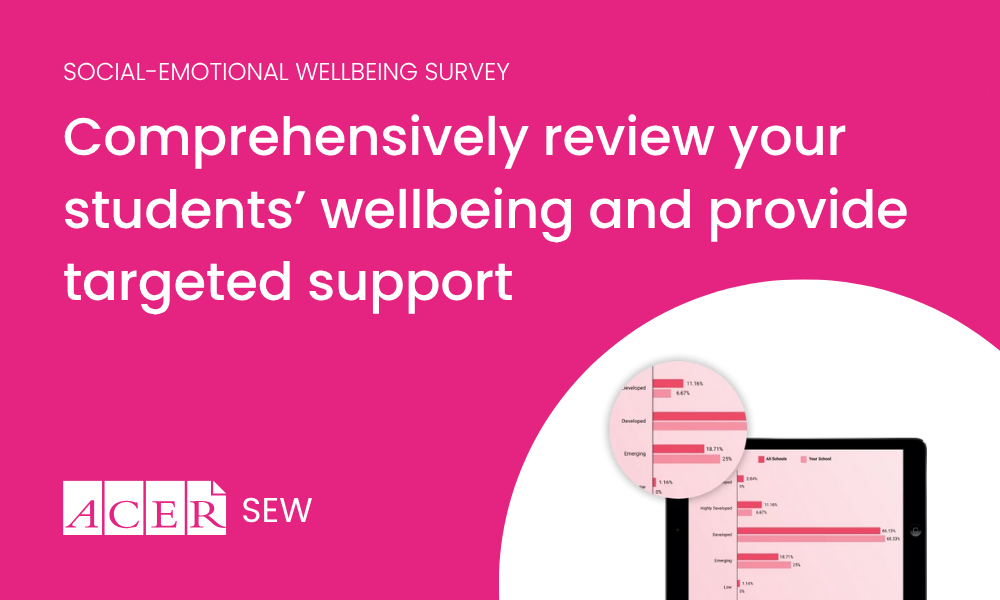Research has shown that higher wellbeing in young people is linked to strong connections with others and well-developed social-emotional skills. The Social-Emotional Wellbeing (SEW) survey is a valuable resource for schools aiming to understand and support the wellbeing of students. Developed by Professor Michael E. Bernard PhD, the SEW survey provides data that helps schools target interventions, allocate resources effectively and communicate wellbeing insights to parents and the broader school community.
About the SEW survey
The SEW survey was originally developed by Professor Michael E. Bernard PhD. His ongoing research with ACER has helped shape a better understanding of social-emotional development in young people.
The survey is designed as a confidential, strength-based tool for students aged 3–18. It can be administered annually or biannually, either school-wide or for specific year levels or groups. Conducted online, the SEW survey offers a safe space for students to respond honestly and allows schools to generate instant reports, supporting timely analysis and action.
The SEW surveys are built around a positive psychology and ecological model of wellbeing. There are 3 versions tailored to different age groups, providing age-appropriate insights into students’ social-emotional development.
Making sense of the data
The survey results offer a detailed view of students’ social-emotional wellbeing – an answer to the question, ‘what’s happening?’. The data helps teachers identify the social-emotional needs of students so they can adjust their teaching practices accordingly. Schools can use the data to set student goals, target resourcing to specific areas of need and measure the impact of wellbeing interventions over time. Pre- and post-survey comparisons provide a clear measure of whether those interventions are making a difference.
Schools can explore their data by:
- comparing their results with national averages to gain perspective on student wellbeing across the wider population
- analysing responses by gender to identify trends within specific student groups
- reviewing response patterns on the Likert scale and examining what percentage of students fall into different categories.
Survey data can also guide the development of student wellbeing policies that address the real needs of students. By incorporating it into mission statements and strategic plans, schools can demonstrate to parents and the community that they are as committed to monitoring and supporting students’ social-emotional wellbeing as they are to academic outcomes.
Interpreting the SEW survey results isn’t just about numbers. Teachers must also rely on their own knowledge of students, their school’s context and everyday interactions. ‘In your school, every student should be known, valued and cared for. Improving student outcomes requires knowledge of the complexity of each student’s needs.’ (NSW Department of Education, 2024)
Supporting teachers and students
There is a range of resources available that support both teachers and families, including materials that focus on students who may face greater challenges, such as First Nations students, culturally and linguistically diverse (CALD) students, those with disabilities, or those from low socio-economic backgrounds. These resources emphasise identifying risk factors and strengthening protective supports around students. The Australian Student Wellbeing Framework highlights the importance of culturally responsive approaches to support Indigenous students' mental health and wellbeing (Australian Government Department of Education, 2016). Additionally, the Australian Institute of Health and Welfare (n.d.) provides insights into the diverse experiences of CALD Australians, emphasising the need for inclusive and equitable support in educational settings. Bernard and Stephanou (2017) further underscore the value of addressing student wellbeing across different ecological levels, including individual, relational, and community factors, recognising that a holistic approach is essential for fostering resilience and positive mental health outcomes among young people.
The importance of staff wellbeing
Staff wellbeing is just as critical as student wellbeing. ‘Self-care is an important component of wellbeing in the workplace, but perhaps more challenging is how schools can implement systemic, long-term change so that the system and the people in it are not constantly trying to operate beyond capacity.’ (Webb, 2025)
Ultimately, the SEW survey is not just a diagnostic tool – it’s a starting point. When combined with professional insight and thoughtful action, it can guide schools toward creating environments where both students and staff can thrive.
Find out more about the survey here.
Explore ACER’s comprehensive directory of student wellbeing programs designed to assist educators in selecting the most appropriate resources for promoting social, psychological and personal health in their learning community. Visit https://wellbeingguide.acer.org/
References
Australian Institute of Health and Welfare. (n.d.). Culturally and linguistically diverse Australians overview. Australian Government. https://www.aihw.gov.au/reports-data/population-groups/cald-australians/overview
Australian Government Department of Education. (2016). Indigenous young people and mental health. Student Wellbeing Hub. https://studentwellbeinghub.edu.au/educators/resources/indigenous-young-people-and-mental-health/
Bernard, M. E., & Stephanou, A. (2017). Ecological levels of social and emotional wellbeing of young people. Child Indicators Research, 11(3), 661–679. https://doi.org/10.1007/s12187-017-9466-7
NSW Department of Education. (2024). Measuring student wellbeing for school improvement. Centre for Education Statistics and Evaluation (CESE). https://education.nsw.gov.au/content/dam/main-education/about-us/educational-data/cese/2024-measuring-student-belonging-for-school-improvement.pdf
Webb, S. K. (2025). Teachers Cry Too: A story of being both trapped by the bell, and saved by it. Amba Press. https://ambapress.com.au/products/teachers-cry-too?srsltid=AfmBOoq7wtXumxprztO72vOCaomB6jxyp6FfGs5W4hPqO06uUxC-tnUh

